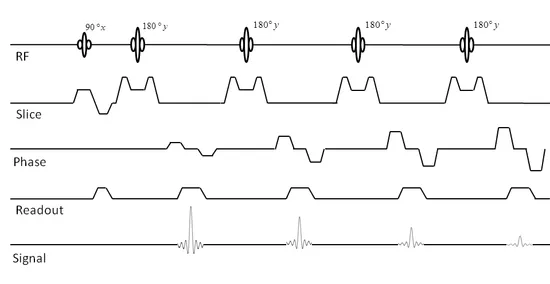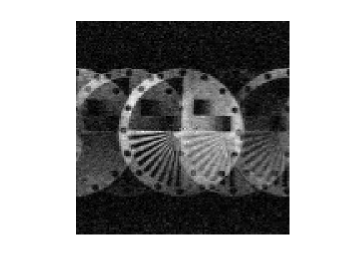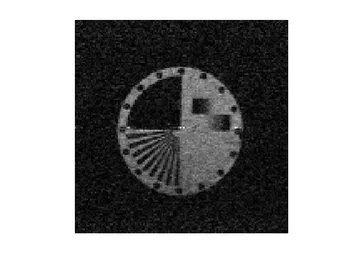RARE
RARE, or Rapid Imaging with Refocused Echoes, also known as Fast Spin-Echo (FSE) or Turbo Spin-Echo (TSE) depending on manufacturer, is a well established rapid imaging technique that speeds up image acquisition by acquiring more than one k-space line per repetition.
RARE-type sequences begin in the same way as the well known spin-echo sequence, with a π pulse used to refocus dephasing spins into an echo. In RARE multiple π pulses are used to create many echoes. By applying a different phase encoding gradient to each echo multiple k-space lines can be collected in one go. The speed up factor compared to a conventional spin-echo sequence is therefore equal to the number of refocusing pulses applied (i.e. using 4 refocusing pulses would result in a x4 speed up). This speed up factor is often referred to as the echo train length, or turbo factor.

This figure shows a typical RARE sequence, in this case with an ETL of 4. Each of these echoes has been encoded by a different strength of phase encode gradient. After each echo has been sampled in the presence of the readout gradient the phase encoding previously applied is undone using a 'rewinder' gradient. This ensures that the encoding applied to one echo does not interfere with any subsequent echoes.
Another feature common to RARE (and many other spin echo sequences) are the gradient 'lobes' on either side of the π pulse selective gradients. These are known as crusher gradients, and act to dephase spurious signal coming from outside the slice of interest. Such signals arise as selective π pulses are difficult to deliver without exciting spins outside the slice of interest. These spins will experience a non π flip angle and will therefore contribute towards the observed NMR signal.
As with all MRI techniques, RARE has advantages and disadvantages over conventional gradient echo imaging. The most obvious advantage is that the image may be acquired faster using RARE; in the most extreme case it is possible to collect an entire data set from a single excitation (e.g. 128 refocusing pulses for a 128x128 image). A further advantage is that by using spin echoes these sequences are very robust with regard to magnetic field inhomogeneities, and so the echo train is modulated by pure T2 as opposed to T2*. Even so, this modulation can cause artefacts in the images obtained. Commonly this manifests as blurring in the phase-encode direction. Furthermore, when there are gradient and sequence timing imperfections, phase errors can creep into the echo train. The artefacts resulting from this are much more severe, but can be corrected for using post-processing.


This example shows the same RARE image before and after phase correction.The method used here involved collecting a single echo train without any phase encoding applied. From this so called 'navigator scan' it is possible to estimate any phase errors which may then be removed from the image raw data before it is fourier transformed.